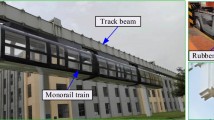Abstract
Ride comfort optimization of a city bus is considered in this article, using stiffness and related damping of the power unit mounts as design variables. The response of the bus, due to road irregularities, is calculated in the time domain by using a finite element (FE) model describing the complete vehicle. The body of the bus is condensed, using a substructuring technique, in order to reduce the simulation times. Operational deflection shapes (ODS) have been used to compare measured and calculated vibrations and some corrections of the FE model have been done. The response, i.e. acceleration, at three locations in the bus has been frequency-weighted according to the comfort standard ISO 2631:1997. The resulting root mean square (RMS) values of these responses are then used in the objective functions in the optimization procedure. The computational results show that it is possible to increase the ride comfort. However, the improvement of the ride comfort is probably too small to have a substantial subjective impact on the passenger in the bus. The results show that the objective function, regarding the overall ride comfort in the bus, has local optima.
Similar content being viewed by others
Author information
Authors and Affiliations
Additional information
Received October 10, 1999
Rights and permissions
About this article
Cite this article
Eriksson, P., Friberg, O. Ride comfort optimization of a city bus. Struct Multidisc Optim 20, 67–75 (2000). https://doi.org/10.1007/s001580050137
Published:
Issue Date:
DOI: https://doi.org/10.1007/s001580050137




